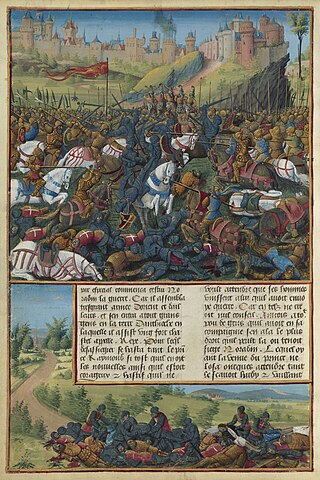Background
After the great Crusader defeat at the Battle of Harran in 1104, all of Antioch's strongholds east of the Orontes River were abandoned. In order to raise additional Crusader reinforcements, Bohemond of Taranto embarked for Europe, leaving Tancred as regent in Antioch. The new regent began to patiently recover the lost castles and walled towns.
In mid-spring 1105, the inhabitants of Artah, which is located 25 miles (40 km) east-northeast of Antioch, may have expelled Antioch's garrison from the fortress and allied with Ridwan or surrendered to the latter upon his approach to the fortress. Artah was the last Crusader-held fortress east of the city of Antioch and its loss could result in a direct threat to the city by Muslim forces. It is unclear if Ridwan thereafter garrisoned Artah.

The Principality of Antioch was one of the crusader states created during the First Crusade which included parts of modern-day Turkey and Syria. The principality was much smaller than the County of Edessa or the Kingdom of Jerusalem. It extended around the northeastern edge of the Mediterranean, bordering the County of Tripoli to the south, Edessa to the east, and the Byzantine Empire or the Kingdom of Armenia to the northwest, depending on the date.

In the Battle of Ager Sanguinis, also known as the Battle of the Field of Blood, the Battle of Sarmada, or the Battle of Balat, Roger of Salerno's Crusader army of the Principality of Antioch was annihilated by the army of Ilghazi of Mardin, the Artuqid ruler of Aleppo on 28 June 1119.

In the Battle of Azaz forces of the Crusader States commanded by King Baldwin II of Jerusalem defeated Aq-Sunqur al-Bursuqi's army of Seljuk Turks on 11 June 1125 and raised the siege of the town.

The Battle of Inab, also called Battle of Ard al-Hâtim or Fons Muratus, was fought on 29 June 1149, during the Second Crusade. The Zengid army of Atabeg Nur ad-Din Zangi destroyed the combined army of Prince Raymond of Poitiers and the Assassins of Ali ibn-Wafa. The Principality of Antioch was subsequently pillaged and reduced in size as its eastern border was pushed west.

The Battle of Harran took place on 7 May 1104 between the Crusader states of the Principality of Antioch and the County of Edessa, and the Seljuk Turks. It was the first major battle against the newfound Crusader states in the aftermath of the First Crusade, marking a key turning point against Frankish expansion. The battle had a disastrous effect on the Principality of Antioch as the Turks regained territory earlier lost.
Ridwan was a Seljuk emir of Aleppo from 1095 until his death.

The siege of Antioch took place during the First Crusade in 1097 and 1098, on the crusaders' way to Jerusalem through Syria. Two sieges took place in succession. The first siege, by the crusaders against the city held by the Seljuk Empire, lasted from 20 October 1097 to 3 June 1098. The second siege, of the crusader-held city by a Seljuk relieving army, lasted three weeks in June 1098, leading to the Battle of Antioch in which the crusaders defeated the relieving army led by Kerbogha. The crusaders then established the Principality of Antioch, ruled by Bohemond of Taranto.

Tancred was an Italo-Norman leader of the First Crusade who later became Prince of Galilee and regent of the Principality of Antioch. Tancred came from the house of Hauteville and was the great-grandson of Norman lord Tancred of Hauteville.
In the Battle of al-Sannabra (1113), a Crusader army led by King Baldwin I of Jerusalem was defeated by a Muslim army sent by the Sultan of the Seljuk Turks and commanded by Mawdud ibn Altuntash of Mosul.
The military history of the Crusader states begins with the formation of the County of Edessa in 1097 and ends with the loss of Ruad in 1302, the last Christian stronghold in the Holy Land.

The FirstBattle of Ramla took place on 7 September 1101 between the Crusader Kingdom of Jerusalem and the Fatimids of Egypt. The town of Ramla lay on the road from Jerusalem to Ascalon, the latter of which was the largest Fatimid fortress in Palestine. From Ascalon the Fatimid vizier, Al-Afdal Shahanshah, launched almost annual attacks into the newly founded Crusader kingdom from 1099 to 1107. It was thrice the case that the two armies met each other at Ramla.
Zardana is a village in northwestern Syria, administratively part of Idlib Governorate. The village lies in a relatively flat plain. Nearby localities include Taftanaz to the southeast, al-Fu'ah and Binnish to the south, Maarrat Misrin and Kafriya to the southwest, Kafr Yahmul to the west, Hizano to the northwest, Ibbin to the north, Kafr Nouran to the northeast and Maaret Elnaasan to the east. According to the Syria Central Bureau of Statistics (CBS) Zardana had a population of 5,767 in the 2004 census.

Latmin is a Syrian village located in the Kafr Zita Subdistrict of the Mahardah District in Hama Governorate. According to the Syria Central Bureau of Statistics (CBS), Latmin had a population of 1,113 in the 2004 census.
Artah was a medieval town and castle located 25 miles east-northeast of Antioch, to the east of the Iron Bridge on the Roman road from Antioch to Aleppo.

The timeline of the Principality of Antioch is a chronological list of events of the history of the Principality of Antioch.
The siege of Aleppo by Baldwin II of Jerusalem and his allies lasted from 6 October 1124 to 25 January 1125. It ended in a Crusader withdrawal following the arrival of a relief force led by Aqsunqur al-Bursuqi.
Luʾluʾ al-Yaya, also called al-Bābā or al-Khādim, was the regent of the Seljuk sultanate of Aleppo from AD 1113 until his assassination in 1117 (510). He was the atabeg (father-lord) of the underage sultans. Previously, he had been a eunuch in the service of Aqsunqur al-Bursuqī, the atabeg of Mosul.
The Lordship of Marash was a territorial lordship in northeastern Cilicia between 1104 and 1149, centred on the city of Marash. One of the lesser Crusader states, it played a major role in the defence of the northern frontier in the 1130s and 1140s under Lords Geoffrey and Baldwin. Its position became untenable after the fall of Edessa in 1146.
This page is based on this
Wikipedia article Text is available under the
CC BY-SA 4.0 license; additional terms may apply.
Images, videos and audio are available under their respective licenses.











